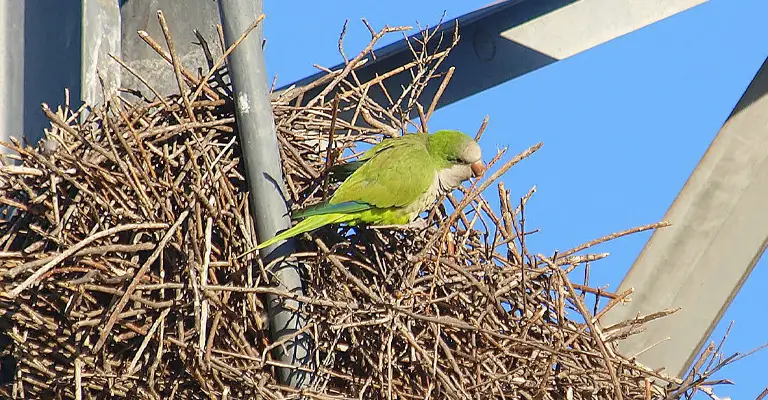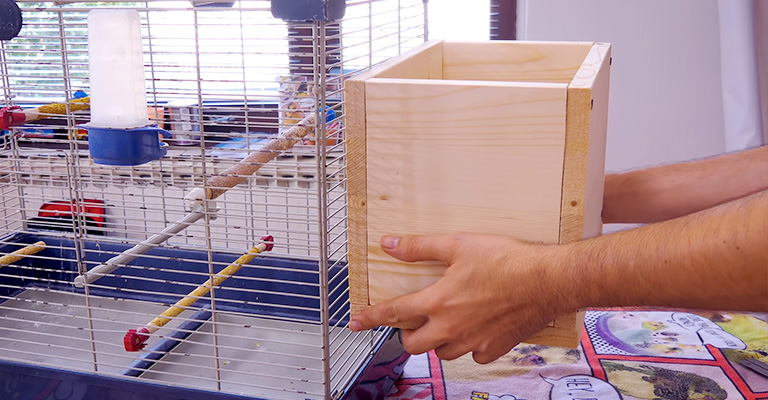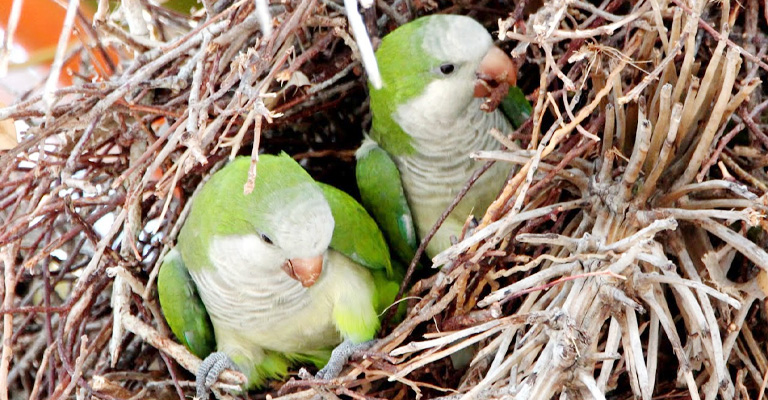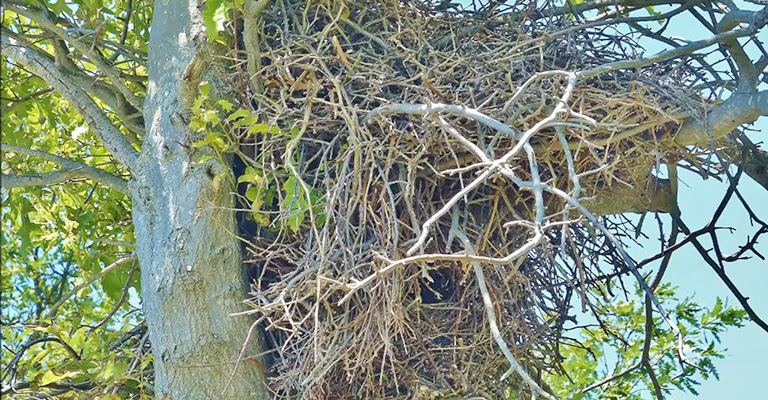Nesting is a fascinating and crucial aspect of a Quaker parrot’s life. These charismatic birds, also known as monk parakeets, are renowned for their communal and cooperative nesting behavior.
In this blog post, we’ll delve into the world of Quaker parrot nests, exploring their nesting habits, preferred nesting materials, and tips for creating the perfect nesting environment.
Quaker parrots’ nesting behavior offers a captivating glimpse into their social dynamics and adaptability. We’ll uncover the secrets behind their communal nests, where multiple pairs collaborate to construct and maintain intricate structures.
From selecting the right nesting materials to providing a suitable nesting box, we’ll provide insights into nurturing a comfortable and secure nesting environment. So, stay focused.

Quaker Parrot Nesting Behavior
Quaker parrots, also known as monk parakeets, exhibit fascinating nesting behavior. They are highly social birds, often forming large colonies in the wild. Their nests are communal, and multiple pairs work together to construct them.
Quakers are excellent builders, creating massive stick nests in trees or man-made structures. These nests can house several pairs, and each pair has its own chamber.
These birds are known for their resourcefulness, using a wide range of materials, including twigs, leaves, and even bits of human-made items like wires or cloth.
During the breeding season, Quaker parrots are dedicated parents, with both partners actively incubating the eggs and caring for the chicks. Their communal nesting and cooperative parenting are unique among parrot species, highlighting their strong social bonds and intelligence.
Choosing the Right Nesting Materials for Quaker Parrot
Selecting appropriate nesting materials for Quaker parrots is essential to ensure their comfort and safety during the breeding process. Here are some tips on choosing the right nesting materials:
Natural Twigs and Branches
Quaker parrots prefer natural materials like twigs and branches for building their nests. These materials mimic their wild nesting habits and provide a stable structure.
Leaves and Greenery
Quakers often incorporate leaves and greenery into their nests for added insulation and comfort. Non-toxic, pesticide-free foliage from safe plants can be used.
Straw and Grass
Clean, dry straw or grass can be suitable for nesting material. Ensure it is free from any contaminants or chemicals.
Soft Bedding
Quaker parrots may appreciate soft bedding materials like shredded paper, coconut fiber, or untreated, dust-free hay. These materials create a cozy environment for eggs and chicks.
Cotton or Fabric Strips
Small strips of natural, untreated cotton or fabric can be included in the nesting material mix. Quakers might incorporate these for added comfort.
Avoid Toxic Materials
Never use toxic or chemically treated materials, such as cedar wood or pine shavings. These can harm the birds or their chicks.
Cleanliness
Ensure all nesting materials are clean and free from contaminants like mold, bacteria, or parasites.
Supervision
If you provide nesting materials, monitor your Quaker parrots to see which materials they prefer and adjust accordingly.
Remember that not all Quaker parrots will readily use provided nesting materials, as some might prefer to construct their nests with only the materials available in their environment.
Selecting the Ideal Nesting Box for Quaker Parrot

Choosing the right nesting box for Quaker parrots is crucial to ensure their comfort and breeding success. Here’s how to select the ideal nesting box for your Quaker parrots:
Size
Opt for a nesting box that is appropriately sized for Quaker parrots. A box that measures around 12-14 inches in height, 8-10 inches in width, and 8-10 inches in depth is generally suitable. It should provide enough space for the birds to move around comfortably.
Material
Select a nesting box made of durable and non-toxic materials. Wood is a common choice. Ensure it is free from any chemicals, paints, or coatings that could harm the birds.
Entrance Hole
The entrance hole should be large enough for the Quaker parrots to enter and exit easily but not so large that it allows predators to access the nest. A hole diameter of approximately 2 inches is a good starting point.
Cleaning Access
Look for a nesting box with a removable lid or side panel. This allows you to access the interior for cleaning or monitoring the nesting progress without disturbing the birds excessively.
Perch
While not necessary, some nesting boxes come with a perch near the entrance. Quaker parrots may use it for convenience, but it’s not a critical feature.
Location
Place the nesting box in a quiet and sheltered location within the cage or aviary, away from disturbances and direct sunlight. Ensure it is securely attached to prevent accidents.
Nesting Material
Provide a variety of nesting materials (as discussed earlier) inside the box for the Quaker parrots to choose from when building their nest.
Monitor
Keep an eye on the nesting behavior of your Quaker parrots. If they reject the nesting box or materials, they may prefer to build their nest elsewhere in their environment.
Remember that not all Quaker parrots will use a nesting box, as some may prefer to nest in more open areas.
How to Prepare the Nesting Area for Quaker Parrot

Creating an ideal nesting area for Quaker parrots is crucial to support their breeding and nesting behavior. Here are steps to prepare a suitable nesting area:
Select a Location
Choose a quiet and secure location within the cage or aviary for the nesting area. Ensure it is away from high-traffic areas and any potential disturbances.
Nesting Box
If you’re using a nesting box (as discussed in the previous response), securely attach it to the chosen location. Ensure the entrance hole is accessible but not easily reached by predators or other birds.
Nesting Materials
Provide a variety of nesting materials inside the nesting area. This can include natural twigs, branches, leaves, straw, grass, soft bedding material (such as shredded paper or coconut fiber), and small strips of cotton or fabric. Ensure all materials are clean and non-toxic.
Food and Water
Ensure there is a nearby source of fresh food and water for the nesting pair. This reduces the need for them to leave the nesting area frequently.
Privacy
Quaker parrots prefer privacy during the nesting period. You can use cage covers or screens to partially shield the nesting area from view. This helps reduce stress and disturbance for the nesting pair.
Temperature and Lighting
Maintain a stable and comfortable temperature in the nesting area, typically around 70-80°F (21-27°C). Ensure there is adequate lighting for the birds to see but avoid exposing them to excessive direct sunlight or drafts.
Monitoring
Keep a watchful eye on the nesting pair to ensure they are comfortable and behaving normally. Regularly check the nesting materials for cleanliness and freshness.
Nesting Behavior
Be patient. Not all Quaker parrot pairs will use a nesting box or designated area. Some may prefer to build their nests in other parts of the cage or aviary.
Safety
Ensure the nesting area is safe and free from hazards. Remove any potential choking hazards or toxic materials from the vicinity.
Minimal Disturbance
Minimize disturbances as much as possible during the nesting period. Avoid unnecessary handling or loud noises near the nesting area.
Remember that not all Quaker parrots will choose to nest, and it’s essential to respect their preferences. Providing a comfortable and secure nesting area and monitoring their behavior will give them the best chance for successful breeding if they decide to nest.
Importance of Monitoring Quaker Parrot Nesting Behavior

Monitoring Quaker parrot nesting behavior is crucial for several important reasons:
Health and Well-Being
Regular monitoring allows you to assess the overall health and well-being of the nesting pair. Changes in behavior, appetite, or physical condition can be early indicators of health issues that need attention.
Breeding Success
Monitoring helps ensure the success of the breeding process. You can observe whether the pair is incubating the eggs properly, feeding the chicks, and providing adequate care. This helps prevent problems like egg abandonment or the Parrot Chick’s neglect.
Early Intervention
If you notice any issues, such as the eggs not hatching, chicks appearing weak or unwell, or parents not attending to their young, you can intervene early to address these problems. Prompt action can improve the chances of a chick’s survival.
Environmental Factors
Monitoring allows you to assess the nesting environment for any potential hazards or changes that may affect the nesting pair. This includes ensuring the nesting materials are clean and safe, maintaining stable temperature and lighting conditions, and preventing exposure to drafts or extreme temperatures.
Behavioral Changes
Quaker parrots can exhibit changes in behavior during the breeding season. Monitoring enables you to observe these changes and understand their nesting behavior better. This can include increased territoriality, vocalizations, or nesting-related activities.
Nesting Material Maintenance
Regular checks on the nesting materials ensure they remain clean and suitable. You can replace materials if they become soiled or contaminated.
Preventing Stress
Minimizing disturbances and stress during the nesting period is essential. Monitoring helps you identify any sources of stress and take steps to mitigate them, promoting a calm and safe environment for the nesting pair.
Documentation
Keeping records of nesting behavior, such as the timing of egg laying, incubation, and chick development, can be valuable for future reference and understanding the breeding patterns of your Quaker parrots.
Bonding and Trust
Monitoring the nesting pair allows you to build trust and a stronger bond with your birds. If they perceive you as a non-threatening presence during this critical time, they may become more accustomed to your presence and handling.
Monitoring Quaker parrot nesting behavior is essential for the health and success of the breeding process.
Troubleshooting Nesting Issues for Quaker Parrot
Troubleshooting nesting issues for Quaker parrots is essential to ensure the well-being of the birds and improve breeding success. Here are some common nesting problems and their solutions:
Egg-Laying Problems
Egg Binding
If a female Quaker parrot is struggling to lay eggs, consult a veterinarian immediately. Egg binding can be life-threatening and requires prompt medical attention.
Egg-Laying without a Nest
Sometimes, Quaker parrots may lay eggs outside the nesting box. Provide a suitable nesting box, and the female may move the eggs inside it.
Abandoned Eggs or Chicks
- Quaker parrots may abandon their eggs or chicks due to stress, illness, or inexperience. Ensure a calm and undisturbed environment for the nesting pair.
- If the parents continue to neglect the eggs or chicks, you may need to consider hand-rearing the chicks or providing additional care.
Chick Health Issues
Weak or sickly chicks may require special attention. Consult a veterinarian or an experienced avian breeder for guidance on hand-feeding and caring for sick chicks.
Frequent Nest Inspection
Avoid frequent or unnecessary nest inspections, as this can stress the birds and disrupt the nesting process. Limit your checks to essential observations.
Lack of Nesting Materials
Ensure an ample supply of suitable nesting materials, including twigs, branches, leaves, straw, and soft bedding materials. Quaker parrots need these materials to construct a proper nest.
Temperature and Lighting Issues
- Maintain a stable and comfortable temperature in the nesting area, typically around 70-80°F (21-27°C). Ensure adequate lighting but avoid exposing the nest to direct sunlight.
- Sudden changes in temperature or lighting can disrupt the nesting process.
Nutritional Support
Provide a well-balanced diet for the nesting pair, including fresh fruits, vegetables, high-quality pellets, and a source of calcium. Proper nutrition is crucial during the breeding season.
Predator Prevention
If your Quaker parrots are breeding outdoors in an aviary, ensure it is secure and protected from potential predators, such as snakes, rats, or other birds.
Bonding and Trust
Build a strong bond with your Quaker parrots to reduce their stress during nesting. Avoid sudden movements or loud noises near the nesting area.
Consult an Expert
If you’re facing persistent nesting issues or are unsure how to address a specific problem, consult with an experienced avian veterinarian or a knowledgeable parrot breeder for guidance.
Remember that not all Quaker parrot pairs will successfully breed or use a nesting box. It’s essential to respect their natural behaviors and preferences while providing appropriate support and care when needed.
FAQs
A suitable nesting box for Quaker parrots should measure around 12-14 inches in height, 8-10 inches in width, and 8-10 inches in depth. It should provide ample space for the nesting pair to move comfortably.
Quaker parrots typically start nesting in late winter or early spring, as this coincides with their natural breeding season. However, the exact timing may vary based on factors like temperature and daylight hours.
While Quaker parrots often prefer natural nesting materials like twigs and leaves, you can provide clean, safe artificial materials like shredded paper or coconut fiber. Just ensure they are non-toxic and easy for the birds to work with.
It’s best to minimize disturbances. Limit nest checks to once a week to avoid stressing the nesting pair. If you notice any issues, like abandoned eggs or sick chicks, consult a veterinarian or experienced breeder promptly.
Not all Quaker parrots will choose to use a nesting box. Some may prefer to build nests elsewhere in their environment. Provide a nesting box as an option, but respect their natural instincts and preferences regarding nesting locations.
Wrapping Up
The intricacies of Quaker parrot nests are not only a window into their fascinating world but also a crucial aspect of their care.
Whether you’re a seasoned parrot enthusiast or a newcomer, providing the ideal nesting environment can enhance the well-being and breeding success of these charming birds.
From the choice of nesting materials to respecting their natural instincts, we’ve explored the essentials of creating a cozy abode for your Quaker parrots. So, embrace your role as a caretaker, and let your Quaker parrots thrive in their nest, a testament to nature’s artistry and adaptability. Best of luck.